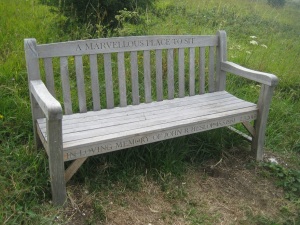We hadn’t been on a long geocaching trip for ages.
We noticed a 30 cache series about an hour’s drive away in North Sussex – called TACT. The cache owner AnTsInRpAnTs named the series The AnTs’ Caching Trail and abbreviated the full name to TACT. We had undertaken some of his(/her?) caches before and enjoyed what we encountered – we were expecting a great day out.
The 30 caches were mainly set in woodland. In each cache there was a bonus number, and using the bonus numbers we would be able to calculate the coordinates to locate a bonus cache, TACT31. Frequently bonus numbers are hidden randomly throughout the route, but this time the Cache Owner had hidden the same bonus number in caches 1-3, another number in caches 4-6, etc and the tenth number was in caches 28-30. This meant providing we found a reasonable number of consecutive caches, we should have the numbers for the bonus.
The Cache Owner had suggested 2 car parking spaces. The first near cache 1, seemed very small when we checked it on Googlemaps, so we decided to park at the other suggested location which was closer to cache 9.
This gave is a problem as the bonus cache, cache 31, was likely to be close to cache 30 (the end of the series) or near to cache 1 (the recommended parking).
But with a little deviation from the suggested route, we thought we could get most of the bonus numbers before arriving at the likely hiding spot for the bonus. Our route was cache 9, 10-14, a short diversion to cache 6, then continue from cache 15 to 30. This would mean we would only be missing the bonus number from caches 1-3.


The woods are very quiet. Many cachers mention in their logs that they don’t see a soul all day. We weren’t quite that lucky, as we saw possibly 3-4 dog walkers and a couple of other ramblers. Most of the times we weren’t near any caches.
The first exception to this was when we were at the only multicache on the route. Most multis take you to a spot and then you collect some numbers to derive the further coordinates. This multi was different. Hidden deep in a fallen tree root were about 10 plastic carrots. We had to ‘pick’ each carrot, examine it and discover the hidden numbers inside. Of course, the carrots we initially ‘picked’ yielded nothing, and it was the final two carrots which were profitable. As were putting the new coordinates in our GPS we were we aware of some dog walkers about 40 yards away. Fortunately they didn’t ask what we were doing, as it would have been a tricky story to make up armed with a plastic carrot in our hand.
Most of the hints were straightforward and yielded a relatively standard cache container. However, just occasionally the hint had to be ‘interpreted’. Two such hints were ‘in line with the bridge’ and ‘French starters’.
The first of these made sense as we walked over one of the many plank bridges as a large tree was directly opposite. ‘French starters’… yielded a snail!
The weather was very good for early October. We could still believe we were still in late Summer temperature-wise, but the brown leaves on many of the trees hinted to the correct season.
All but one the caches had been found a few weeks before our trip. We decided to have a good search for this previously ‘unfound’ cache. It had been logged as ‘Did not Find – too many brambles’, so we took heed of this comments and managed to find a small path which went behind most of the brambles and led to an easy find.



Shortly after the we joined the Sussex Border Path – a path we walked part of during our Sandhurst (Berkshire) to Sandhurst (Kent) walk in 2018. This section of the path cuts through the grounds of the Rikkyo school (A Japanese School), and shortly after a war memorial to a WWII plane crash overhead.
Our pause for reflection at the memorial stone, must have affected our navigational skills. As, shortly after leaving it, we totally lost the footpath ! The GPS pointed yards into a vast thicket of brambles, but no footpath could we see. Eventually we found something better than brambles, and it was a relief to find the cache too, which meant we were back on route!
We were approaching caches 28-30, which would yield the last of the bonus numbers we could find without recourse to caches 1-3. We did some quick calculations to verify the bonus cache was not in the vicinity of caches 29-30 (it wasn’t), and continued our walk to cache 30.
At this point we had found every cache we had attempted. (A rarity!) We didn’t want to DNF a cache this late in the trail.
But cache 30 caused us some angst. A familiar hiding place. A stile surrounded by bushes. The bushes lent themselves to ‘hanging’ a cache. But we couldn’t find the cache. We checked both sides, we checked the stile, we checked the GPS, we checked previous logs, we checked the stile again, the checked the bushes again… and eventually on our fourth check, we found the cache! Phew!
Having found cache 30, we had a good idea that the bonus – cache 31 – would be nearby. We were still missing one number (because we hadn’t found the number in caches 1-3), but we could make some appropriate guesses. We tried one number and drew a blank, We guessed at another. Another blank. At our third attempt we were pointed at a very reasonable hiding place. We both looked, and after a few seconds Mr Hg137 saw the cache – an ammo can! Well worth finding the bonus!
After our successful find, we had only a few more caches to find (1-3, 4,5, 6 and 7). Most were straightforward finds, though one did require walking some yards past the cache and walking back and going up a steep bank).
When we finished we had found 31 caches. This equalled our second highest number of caches found in a day. No wonder we were quite exhausted ! It took our total caches found to 3998. So close to 4000 !
A couple of the other caches we found were :























































































































